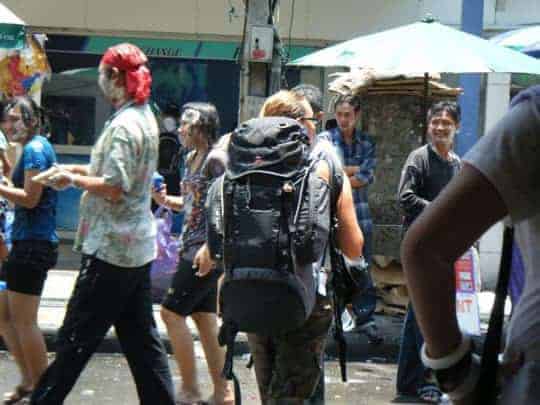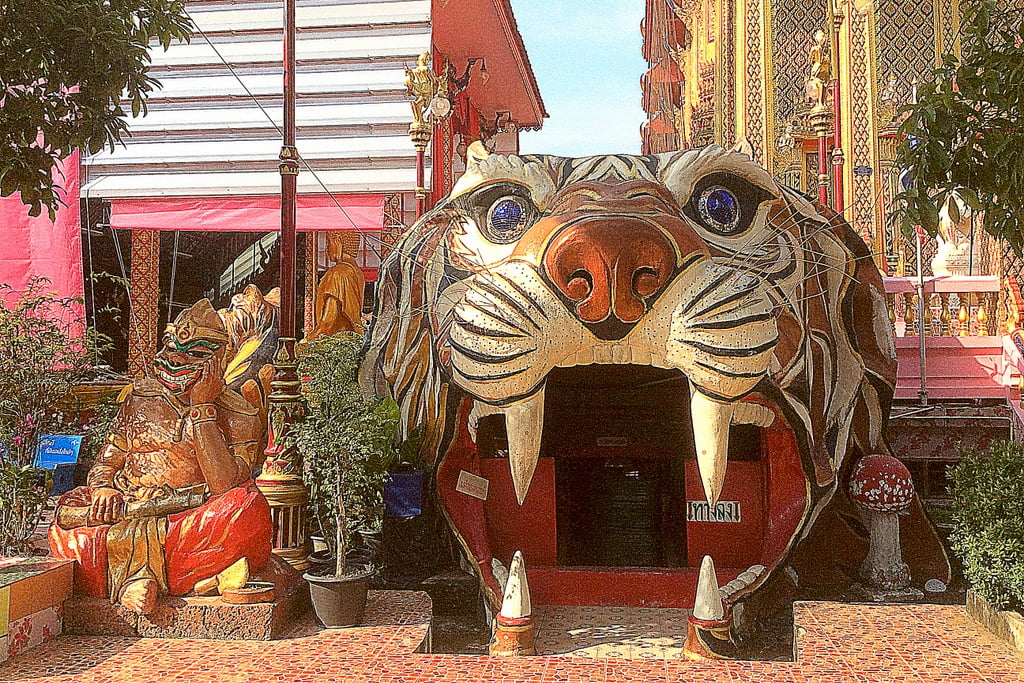Songkran is an important event to celebrate Buddhist New Year in Thailand. If you happen to be in the country mid-April (usually around 13th-16th), you can’t help but get involved in the world’s biggest water fight!
Up and down the country, people of all ages gather together in the streets to celebrate in the wettest way possible. Garden hoses, water pistols 🔫, super soakers and buckets (filled with ice cold water) are thrown at everyone and anyone. It’s absolutely impossible to stay dry during the festivities as children loiter at corners waiting for victims who have not yet been completely drenched. 💦
So, if you can’t beat them, join them! Get yourself kitted out at the local 7-11 with the best water pistol money can buy and become part of the excited crowds in this one-of-a-kind Thai festival!
Related: (opens in new tab)
The History of Songkran
Songkran is the welcoming of the Buddhist New Year in Thailand and spiritually signifies new beginnings, washing off the previous year and starting afresh. The watery madness that exists today evolved from a Buddhist tradition dating back thousands of years.
An important New-Year ritual is to cleanse or bathe Buddha images by gently sprinkling them with scented water, a ceremony believed to symbolise purification, grant prosperity and bestow good fortune in the year ahead. The exuberant soakings of today originate from this gentle tradition, as people pay respect and wish good luck to others by gently pouring this ‘blessed’ water on each other’s shoulders. In many cities across the land, Buddha statues and images from the temples are paraded through the streets on floats for people to throw water over them.
As well as celebration, it is also an important time to reunite with family members and pay respect to elders. On the first day of the festival, Thai people clean their houses to welcome in the New Year and visit temples to pray and offer food to the monks.



Traveller’s Guide to Songkran
When Does Songkran Happen?
Songkran takes place mid-April, usually around 13-16th of the month. The specific date changes each year to coincide with the Full Moon. 🌕 However, many towns and cities have their own schedules and water throwing can start a few days before and continue a few days after the main event – so be prepared at all times, especially if you’re carrying electronics!
Songkran Etiquette ⏰
In theory, drenchings should only happen during the hours of daylight. People should stop throwing water after 6 pm, or when the sun goes down. It’s considered ‘foul play’ to squirt someone after dark – but hey, not everyone plays by the rules! 😈
Where Does Songkran Happen?
The festival takes place all over Thailand, in every village, town and city across the country. Nowhere is a splash-safe zone. However, you’ll find larger festivities and some music concerts taking places in the bigger towns and cities.
Top 5 Places to Enjoy Songkran in Thailand
Chiang Mai: 1️⃣ The number one place to experience Songkran has to be Northern Thailand’s capital of culture, Chiang Mai. Thousands of people descend on the city to celebrate Songkran in a seriously BIG way. Pick-up trucks circle the moat armed with endless supplies of water soaking anyone within reach, some making sure that it is ice cold for added effect! Music blasts from bars and people dress in the ubiquitous brightly coloured flowery shirt as Chiang Mai Old Town becomes a non-stop party – for three whole days!

Note 🤮 If you’re in Chiang Mai for Songkran, be warned that the dirty brown moat water will get used as ammunition. Keep your mouth closed to avoid swallowing it, and be sure to wash your hands before eating.



Bangkok: Tourists and locals alike head to Khao San Road, Silom Road and Sukhumvit Road to enjoy the festivities. Here, you will not only get completely drenched, but you will also likely be covered in talcum powder which is smeared over people’s faces and in their hair.
Koh Phangan: The infamous Full Moon Party on Haad Rin Beach usually takes place a day or two before the Songkran celebrations kick off, but you’ll still find people throwing water over each other before the official start date. The party then continues for the whole week!
Kanchanaburi: It’s Songkran with a difference in Kanchanaburi, a small riverside town two hours west of Bangkok. Locals and tourists can rent a bamboo raft for the day and use it as a vehicle to travel along the tributaries of the River Kwai in order to soak those having a picnic on the riverbank! In the town, cheap alcohol (10 Baht for a rum & coke!) and great live music ensure a party lasting into the night.
Phuket: Bangla Road is at the centre of the action as locals and tourists come out to celebrate together on one of Thailand’s most popular holiday islands. Phuket’s beautiful beaches provide the perfect place to dry off after a thorough soaking.

Buddhist New Year Elsewhere in Southeast Asia 💧
There are similar festivals in the predominantly Buddhist countries of Cambodia (Pchum Ben), Laos (Pi Mai) and Myanmar (Thingyan) to welcome Buddhist New Year. While the soakings do happen in each country, nowhere is quite as wet and wild as Thailand!
Is Travel Possible During Songkran?
It is not a good time to travel during Songkran, though it’s still possible. If you have a plane, train or bus to catch, take an enclosed taxi directly to and from the airport, train station or bus station (forget tuk tuks and motorbikes if you want to stay dry!). Use a waterproof backpack cover, wrap up any valuables and electronics in zip-locked plastic bags and take a change of clothes, just in case you are soaked along the way! One tip is to plan to travel really early in the morning or late at night to try to avoid the worst of the shenanigans – even if you end up being very early for your departure, at least you and your stuff will be dry!



Beware Songkran Roads 🏍️ 🛑
Riding a motorbike is extremely dangerous during Songkran and should be avoided at all costs. You never know from which direction you may get soaked or have an ice-cold bucket of water thrown at you, causing you to swerve and possibly crash. Plus, the roads are really slippery with water, soap and talcum powder, which adds an extra challenge! 🙈 In 2024, there were 243 fatal road accidents during Songkran.

Do Places Close During Songkran?
7-11’s and supermarkets are still open, but many other shops do close during Songkran. Restaurants and bars will be open but if you sit outside, don’t think that you can avoid getting sprayed with water while you’re eating your food!
It’s Just Water, Right?
It’s not just water. For added shock factor, many people add big chunks of ice to those buckets full of water, so you may cool down a lot more than you think! 🧊 Foam is also becoming an extra ingredient in many water buckets lately, which makes roads very slippery for driving! In the villages and in many parts of Bangkok, you’ll find that the water is mixed with scented talcum powder and then smeared all over your face. Apparently, the talcum powder is meant to signify the sins of your past year, which are then washed away.
Tips for Surviving Songkran
- Sunglasses or goggles: Don’t want to get water in your eyes? Keep your sunglasses on at all times – those high-pressure water pistols can be powerful. If you want added protection, why not wear a snorkelling mask? Many do! You may also like to wear earplugs to avoid too much water going into your ears as people have been known to get ear infections.
- Electronics: Mobile phones, cameras, electrical goods of any kind will get wet! You can try to wrap them up in plastic bags, but unless you have a really really good waterproof bag, our advice is to leave them at home.
- Remember, nowhere is off-limits: Don’t think because you are out in the countryside in the middle of nowhere that you will be able to stay dry. Songkran takes place all over the country and rest assured that a child will find you driving around happily on your motorbike in a remote province and chuck a bucket over your head.
- Don’t forget to reapply the sunscreen: It’s the hottest time of the year in Thailand, so wear sunscreen and be sure to reapply generously to make up for the water washing it off!
- Stay hydrated: Drink some water as well as throwing it all over everyone and go easy on the alcohol.
My Personal Songkran Experience
During my first, second and third year living in Thailand, I didn’t merely survive Songkran, I fully embraced the crazy festival to the max! I bought the best super-soaker that I could find and was out there immersed in the water war for all the daylight hours that I could manage.



The fourth year came and I decided that I could handle just one day of the festival, rather than three. During the fifth year, I stayed safe inside my beach bungalow in Koh Phangan and let the madness go on without me. There was a drought in Thailand that year and yet Songkran went on as normal. Tut tut, I thought as I heard the frivolities going on outside my room. It suddenly dawned on me. In five short years, I had become a Songkran Scrooge! So is it your first Songkran? Or are you jaded like me?
If it’s your first Songkran, it’s okay to be a little nervous about the madness that is about to ensue… You know those events that are hyped up to the max and then are a bit of an anti-climax? Songkran is the complete opposite of that! It is wetter, wilder and crazier than you can ever imagine.
So, as people gear up for the world’s biggest water fight, if you’re secretly dreading the whole thing and are wondering if it’s okay to book yourself a posh hotel, buy lots of beer and avoid the next 3-5 days, don’t worry – you’re secret is safe with us. 😉




